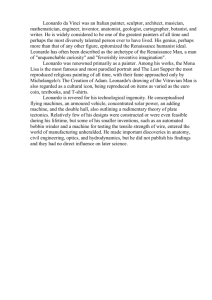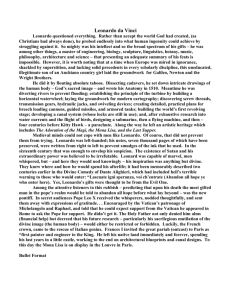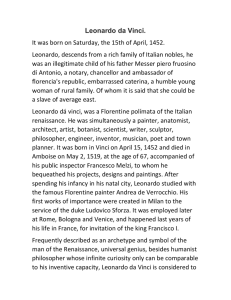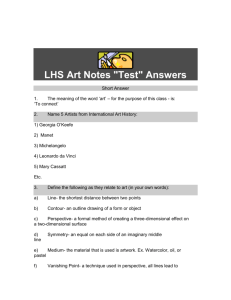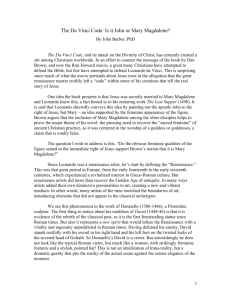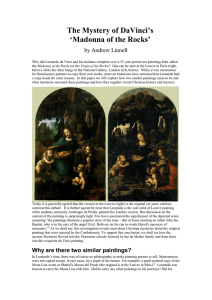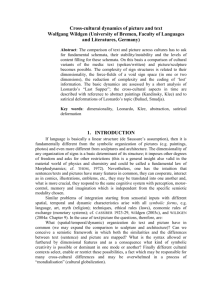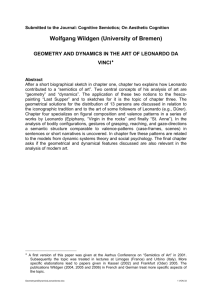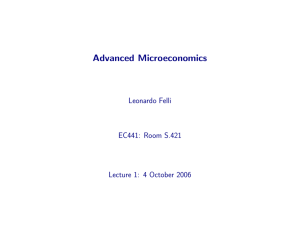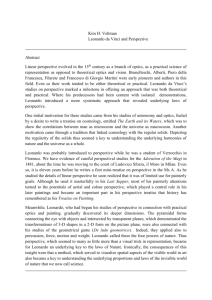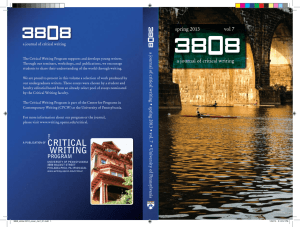Leonardo da Vinci
advertisement
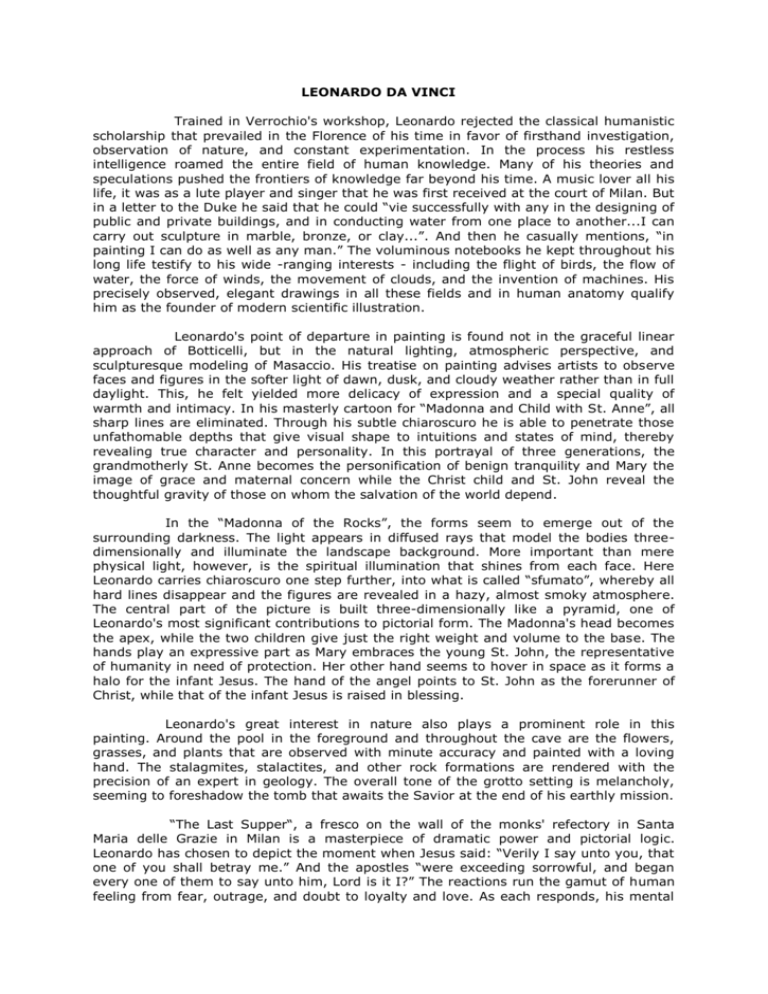
LEONARDO DA VINCI Trained in Verrochio's workshop, Leonardo rejected the classical humanistic scholarship that prevailed in the Florence of his time in favor of firsthand investigation, observation of nature, and constant experimentation. In the process his restless intelligence roamed the entire field of human knowledge. Many of his theories and speculations pushed the frontiers of knowledge far beyond his time. A music lover all his life, it was as a lute player and singer that he was first received at the court of Milan. But in a letter to the Duke he said that he could “vie successfully with any in the designing of public and private buildings, and in conducting water from one place to another...I can carry out sculpture in marble, bronze, or clay...”. And then he casually mentions, “in painting I can do as well as any man.” The voluminous notebooks he kept throughout his long life testify to his wide -ranging interests - including the flight of birds, the flow of water, the force of winds, the movement of clouds, and the invention of machines. His precisely observed, elegant drawings in all these fields and in human anatomy qualify him as the founder of modern scientific illustration. Leonardo's point of departure in painting is found not in the graceful linear approach of Botticelli, but in the natural lighting, atmospheric perspective, and sculpturesque modeling of Masaccio. His treatise on painting advises artists to observe faces and figures in the softer light of dawn, dusk, and cloudy weather rather than in full daylight. This, he felt yielded more delicacy of expression and a special quality of warmth and intimacy. In his masterly cartoon for “Madonna and Child with St. Anne”, all sharp lines are eliminated. Through his subtle chiaroscuro he is able to penetrate those unfathomable depths that give visual shape to intuitions and states of mind, thereby revealing true character and personality. In this portrayal of three generations, the grandmotherly St. Anne becomes the personification of benign tranquility and Mary the image of grace and maternal concern while the Christ child and St. John reveal the thoughtful gravity of those on whom the salvation of the world depend. In the “Madonna of the Rocks”, the forms seem to emerge out of the surrounding darkness. The light appears in diffused rays that model the bodies threedimensionally and illuminate the landscape background. More important than mere physical light, however, is the spiritual illumination that shines from each face. Here Leonardo carries chiaroscuro one step further, into what is called “sfumato”, whereby all hard lines disappear and the figures are revealed in a hazy, almost smoky atmosphere. The central part of the picture is built three-dimensionally like a pyramid, one of Leonardo's most significant contributions to pictorial form. The Madonna's head becomes the apex, while the two children give just the right weight and volume to the base. The hands play an expressive part as Mary embraces the young St. John, the representative of humanity in need of protection. Her other hand seems to hover in space as it forms a halo for the infant Jesus. The hand of the angel points to St. John as the forerunner of Christ, while that of the infant Jesus is raised in blessing. Leonardo's great interest in nature also plays a prominent role in this painting. Around the pool in the foreground and throughout the cave are the flowers, grasses, and plants that are observed with minute accuracy and painted with a loving hand. The stalagmites, stalactites, and other rock formations are rendered with the precision of an expert in geology. The overall tone of the grotto setting is melancholy, seeming to foreshadow the tomb that awaits the Savior at the end of his earthly mission. “The Last Supper“, a fresco on the wall of the monks' refectory in Santa Maria delle Grazie in Milan is a masterpiece of dramatic power and pictorial logic. Leonardo has chosen to depict the moment when Jesus said: “Verily I say unto you, that one of you shall betray me.” And the apostles “were exceeding sorrowful, and began every one of them to say unto him, Lord is it I?” The reactions run the gamut of human feeling from fear, outrage, and doubt to loyalty and love. As each responds, his mental and emotional state is reflected in the searching facial expressions and eloquent gestures that plumb the psychological depths of each character. In the process the defiant Judas is isolated as the one who really knows. He is drawing back, his face in deep shadow, his hand clutching the moneybag containing the fatal 30 pieces of silver. Of him Jesus said: “Behold, the hand of him that betrayed me is with me on the table.” To contain this highly charged scene Leonardo devised a setting of spaciousness and stability. All the lines of the walls and ceiling beams converge in the exact middle, directly behind the head of Christ in perfectly realized linear perspective. The light from the center window, with the curved pediment above, functions as a halo around his head. At the table the revealing gestures of the hands also focus attention toward the center. As an underlying motif Leonardo draws on his Florentine heritage of harmony as expressed in numbers, in this case the symbolism and properties of the number 12. The twelve apostles appear in four groups of three on either side of the lonely central figure. There are four wall hangings on each side and three windows, alluding to the four gospels and the Trinity. Twelve also refers to the passage of time - the hours of the day and months of the year - in which human salvation is to be sought. Always thoughtful and deliberate in his working methods, Leonardo found the usual fresco technique of rapid painting on wet plaster uncongenial. Instead, he experimented by mixing oil pigments with tempera in order to lengthen the painting time, get deeper colors, and work in more shadow effects. Unfortunately, the paint soon began to flake off the damp wall. Over the years it has been so often restored and repainted that only a shadow of its original splendor remains. It is still possible, however, to admire the overall design, the dramatic deployment of gestures of the figures and some of the color tones. All the heads have been repainted so that the intensity of the facial expressions can only be recaptured through the few preparatory drawings that have survived. A particularly poignant one is the profile of Philip, who is standing third to the right of Christ. Leonardo's ambitions, conceptions, and projections far exceeded his capacity to realize them in tangible form. None of his buildings progressed beyond the planning stage, his sculptures have all perished, and only about 17 generally accepted paintings remain. These include four that are unfinished, while the others exist in varying states of preservation, restoration, and repainting.
